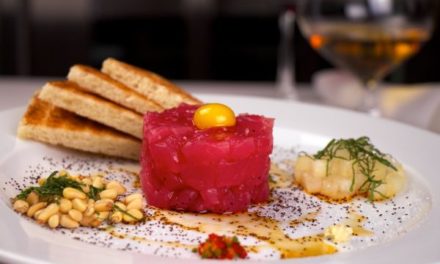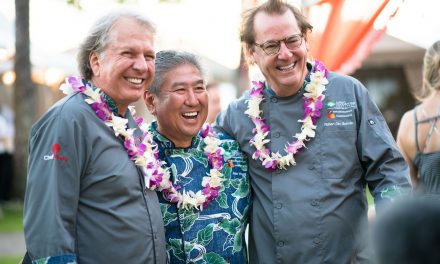“I was always told to use the proper tool for the proper job,” said chef Michael Mina, reflecting on the importance of correct knife use in the kitchen. Many chefs, including Mina, have perfected their knife skills to create the best dishes possible. “The saying was always small job, small knife, large job, large knife.” Knives are a very important chef’s tool, and the different types of knives as well as the different cuts, are concepts that every chef, even those just starting at home, should understand.
When starting to prepare ingredients, chefs first need to ensure they are using the right type of knife. Mina explained the different knives he uses for the many cutting tasks he takes on. “For fine slices and dices, I like to use Japanese chef knives. For heavy duty tasks like splitting pumpkins and gourds, I like to use a 10 to 12-inch heavy duty German steel knife like a Wustof. For carving meats, I like to switch between a Japanese Sujihiki slicer or a serrated slicer with a length of nine to 10 inches long.” Chef Spike Mendelsohn, who often works with vegetables, specified to use a tourne knife on potatoes.
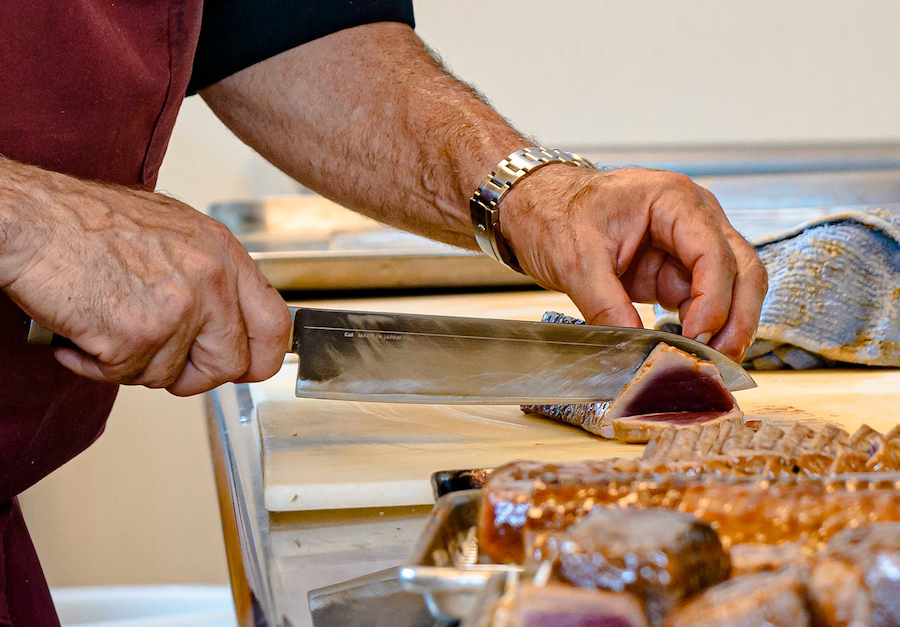
Not only is choosing the proper knife for the task important, but also the grip and skills that user applies help achieve the perfect cut. Photo: Reid Shimabukuro/Hawaii Food & Wine Festival, 2020
Both chefs enjoy using Japanese-style knives, and Mina’s personal favorite is the 210mm Gyuto Japanese knife. Chef Satoshi Kawaguchi, executive chef of Morimoto Asia Waikiki & Momosan Waikiki, supported this idea and said, “I recommend using a chef knife, specifically a Gyuto knife, at home because it’s universal and easy to manage.”
“The type of grip means everything,” explained Mendelsohn, who mentioned that knife handlers should make sure they have full control of the tool. “Make sure to have your thumb and index finger squeezing onto the blade [and the rest of your hand on the handle] for full control of both the blade and the handle.” Mina added a common mistake he sees in knife users: “[Many people wrongly use] a combination of not curling in your fingertips and not holding the knife right with a firm and solid grip.” They also stress the importance of keeping the knife sharp.
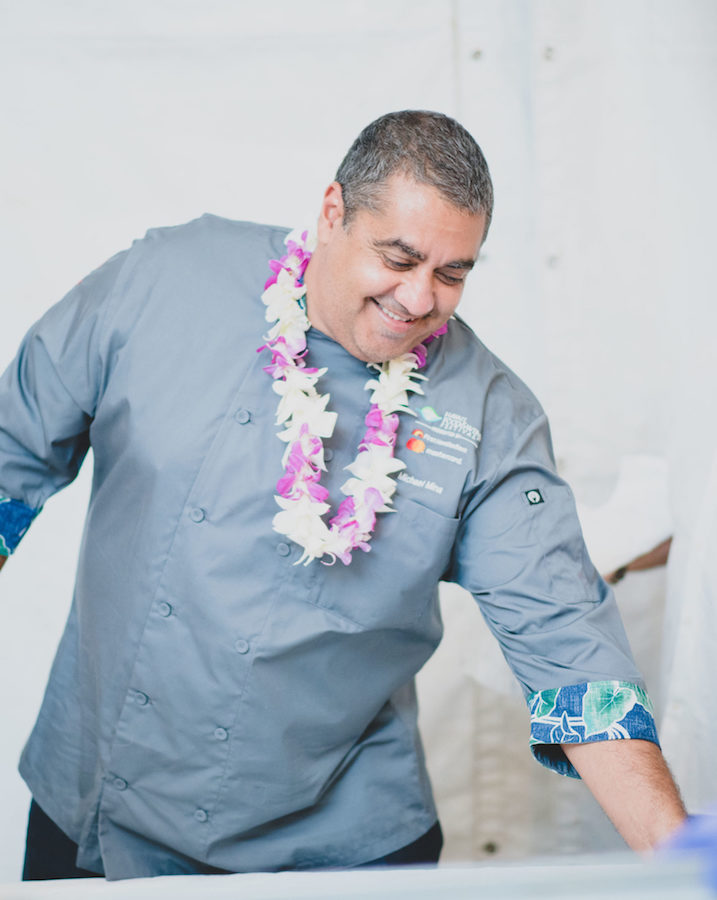
Chef Michael Mina preparing his dish at HFWF18. Photo: Kris Labang/Hawaii Food & Wine Festival, 2018
After chefs have control of their knife, they can work on mastering the many different knife techniques. Even cuts are important to ensure consistency in cooking. “Proper and consistent cuts will cook evenly and timely,” said Mina.
Mendelsohn explained the many types of cuts: “Many knife techniques come from classical French techniques.” He mentioned the julienne cut, for long strips, the brunoise cut, for small dices, and the allumette cut, often seen used for matchstick potatoes. Another example is oblique cuts, which Mendelsohn uses for carrots by rolling the carrot as he cuts it. “The oblique cut allows the flat surfaces [of the carrot] to caramelize while searing and intensifies the flavor.” Not only do correct cuts increase the quality of the look and texture of vegetables, but they also solidify nutrients.
Kawaguchi specified the importance of knife skills when dealing with fish. He explained that he uses a Deba knife to fillet a fish because “the Deba blade separates the bone and meat more efficiently because a Deba knife is a single-edged knife and thick.” The proper technique for filleting fish? “Action of force from right to left is smooth and easy.” A Yanagiba knife, which is a long, thin, single-edged knife, is best for slicing sashimi and nigiri when preparing sushi. “Length is required to pull and slice the fish at once,” and the thin blade is helpful when dealing with sensitive meat. For sushi, Kawaguchi recommends “cutting against the fiber because you can feel a more smooth texture in your mouth.”
Try Michael Mina’s Tartare of Ahi Tuna
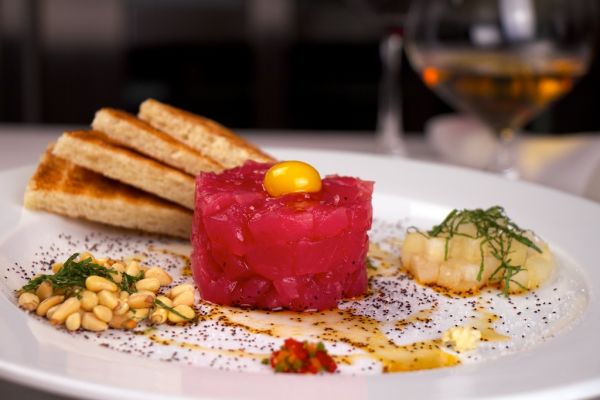
For sushi and sashimi dishes that require fine slicing, like this Tartare of Ahi Tuna, Michael Mina recommends a sharp Japanese chef knife and Kawaguchi recommends “cutting against the fiber because you can feel a more smooth texture in your mouth.” Photo: courtesy of MICHAEL MINA Bellagio
Mendelsohn also discussed other vegetables which benefit from a great cut. “Many people cut mushrooms too thin or too small, and since mushrooms are mostly moisture, they shrink to nothing. By cutting mushrooms thicker, you ensure that they caramelize and sear.”
Brussel sprouts can be shredded for a salad with a vinagrete or cut in half and thrown in a fryer for a bitter and roasty flavor. Mendelsohn mentioned the root of the broccoli as well, which people can slice up for a nutrient dense addition to a dish, instead of throwing it away after chopping up the florets.
Lastly, Mendelsohn explained that there are two ways to cut an onion, depending on its use. For sauteed or caramelized onions, chefs should cut with the grain. “The onion won’t break down or turn to mush and will maintain its texture while being cooked on low heat.” However, for an onion marmalade or jam, chefs should cut against the grain. “The cut will allow the onion to break down and turn to puree, making it spreadable.” Kawaguchi added, “If you cut it against fiber, you taste more bitter and lye, or harshness,” while cutting along the fiber for both fish and vegetables creates a sweeter taste.
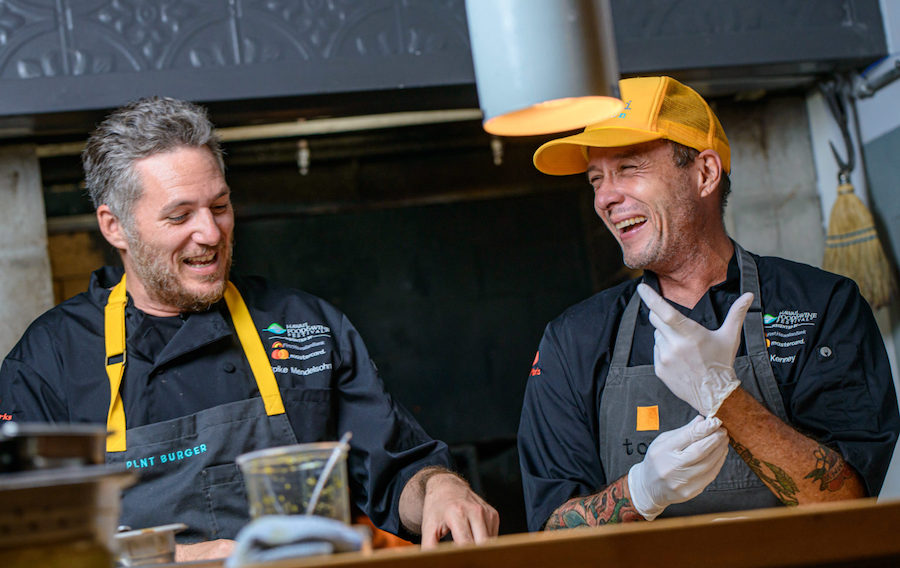
Chefs Spike Mendelsohn and Ed Kenney preparing dishes in the kitchen before a HFWF20 event. Photo: Reid Shimabukuro/Hawaii Food & Wine Festival, 2020
Mendelsohn mentioned a stir fry as a great dish to make while practicing knife skills. “Most Asian style cuisine is very fast cooking at the last minute, so it’s all about the knife cuts,” he explained. The stir fry could include mushrooms, onions, nuts which a chef might squish with the side of their knife, scallions, julienne carrots, root vegetables, and shaved brussel sprouts —all great ingredients to practice cutting. Both Mina and Mendelsohn emphasized that the best way to master the knife is through practice, so start chopping today!
Serves 4 | By Michael Mina
1 pound sashimi grade tuna, cleaned
¼ tablespoon garlic, minced fine
2 pears, skins removed and cut into small dice
1 tablespoon lemon juice, mixed with 1 cup water for holding pears
2 green jalapeno, minced, seeds reserved
2 red jalapeno, minced, seeds reserved
¼ bunch mint leaves, picked from stems and cut into chiffonade
6 tablespoon pine nuts, toasted
¾ cup sesame oil, chili infused
8 slices of white bread for toast
6 quail Eggs, separated. Yolks reserved (whole)
1 ½ tablespoon salt
½ tablespoon white pepper
2 tablespoon ancho chili powder
To prepare
Cut the tuna into small cubes. Be sure that no sinew is left behind. Store chilled. Remove the seeds and pith from the chilies, reserve. Dice the chilies into a fine brunoise and mix the colors together. Add the chili seeds and scraps to the sesame oil. Heat very lightly and allow the chilies to infuse the oil. Strain through a fine mesh strainer when the desired heat is achieved. Cool. When all of the other ingredients are prepared you are ready to plate.
To plate
Be sure that the plates are well chilled to ensure the dish is served cold. Working with 2½ inch x 3 inch ring mold pack the tuna firmly and evenly in the mold. Unmold into the center of the plate being sure to make a small indention with your finger in the center of the top. This will give the egg a resting place. Drain the pears thoroughly and place 2 tablespoons at the 9 o’clock position. Place about 1½ teaspoons of the minced chilies at 7 o’clock, 1/16 teaspoon of garlic at 5 o’clock and 1 ½ tablespoons of pine nuts at 3 o’clock. Adjust these amounts depending on your personal taste. Season with about 1/3 tablespoon salt and a pinch of white pepper over the top of each plate. Sprinkle evenly with ancho powder and mint. Place a quail egg yolk on top of the tuna mold. Drizzle 3-4 tablespoons of the infused sesame oil on top of and around each plate. Serve with toast points (crusts removed).
To serve
Using a fork and spoon, mix the ingredients vigorously in front of the guests or get everyone involved in the process. Once everything is well mixed, reshape the tuna into an appealing shape, i.e. square or triangle.
Alternate preparation
All of the ingredients can be mixed in a bowl ahead of time and then molded and served. In this case you would want to reserve enough ancho powder and mint to garnish the plates.


